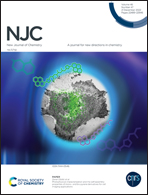Constructing α-AlH3@polymer composites with high safety and excellent stability properties via in situ polymerization†
Abstract
In this study, various polymer materials, such as polystyrene (PS), polymethyl acrylate (PMA), and polyvinyl pyrrolidone (PVP), are successfully encapsulated on the surface of alpha-aluminum hydride (α-AlH3) by the in situ polymerization method. The different polymers on the surface of α-AlH3 can lead to a tremendous enhancement of the material in terms of different properties. Due to the good heat resistance of PS, α-AlH3@PS composites take 625.25 min to lose 1% mass, and the activation energy increased by 11.72 kJ mol−1 compared with that before coating, showing good thermal stability. The high degree of cross-linking polymerization of PMA on the surface isolates α-AlH3 from an external environment, enabling it to maintain a high heat of combustion even after extreme humidity and heat treatment respectively. In addition, PVP has a high adsorption capacity for α-AlH3, which can not only improve the thermal and wet stability of α-AlH3 but also increase its electrostatic susceptibility from 24.6 mJ to 163.2 mJ. The in situ polymerization of encapsulated α-AlH3 has promising applications in aerospace and weapon fields, and the resulting α-AlH3@PVP has potential applications in solid propellant formulations.



 Please wait while we load your content...
Please wait while we load your content...